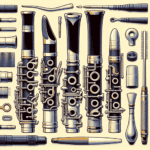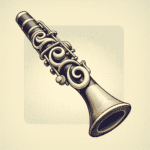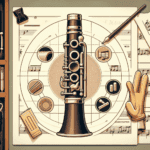The clarinet mouthpiece is a key component that greatly influences your tone and playing experience. The mouthpiece facing, in particular, plays a crucial role. This guide will help you understand mouthpiece facings, their impact on sound production, and how to choose the best one for your needs.
What is a Clarinet Mouthpiece Facing?
The mouthpiece facing refers to the area that contacts the reed. It encompasses the angle and length of the facing curve. The facing design significantly affects the clarinet's response, intonation, and overall tone. By understanding mouthpiece facings, clarinetists can make better decisions that align with their playing style and preferences.
Types of Mouthpiece Facings
Mouthpiece facings have two main characteristics: length and curve. These features combine to create various facing types suitable for different playing styles:
- Short Facing: Offers quick response, favored by players of fast passages. May produce a sharper tone.
- Medium Facing: A versatile option balancing playability and tone quality, suitable for various musical styles.
- Long Facing: Produces a broader, richer sound, often preferred by classical clarinetists who prioritize tonal richness over quick responses.
| Facing Type | Characteristics | Best Suited For |
|---|---|---|
| Short Facing | Quick response, sharper tone | Fast passages, jazz |
| Medium Facing | Balanced playability and tone | Versatile, various styles |
| Long Facing | Broader, richer sound | Classical music, lyrical passages |
How Does Facing Length Affect Tone?
The facing length directly impacts sound production. Here's how it can influence your performance:
- Short Facings: Allow for more pronounced projection, ideal for bright and lively pieces. Beneficial for projecting sound in larger settings like orchestras or bands.
- Medium Facings: Provide a balance between projection and warmth in tone, suitable for both soloists and ensemble players.
- Long Facings: While requiring more air support, they tend to produce a mellow, unique sound, perfect for lyrical passages where warmth is key.
How Does Facing Curve Affect Playability?
The facing curve is also important:
- Flat Facings: Provide crisp attack and control, often preferred by jazz players for versatility and agility.
- Concave Facings: Promote a warmer tone and smoother transition between notes, often chosen by classical clarinetists.
- Convex Facings: Rarely used, this style can lead to a slower response but may suit specific styles or preferences.
Choosing the Right Mouthpiece Facing
To select the appropriate facing, consider your playing style, music genre, and personal preferences:
- Assess Your Playing Style: Are you more inclined towards classical music or jazz? Different genres often benefit from specific facing characteristics.
- Try Different Options: Test various mouthpieces with different facings to see how they affect your response and tone. Find a music store that lets you try out different mouthpieces.
- Get Expert Advice: Talk to a clarinet teacher or professional player for insights tailored to your specific needs.
Mouthpiece Maintenance
Proper mouthpiece care can enhance its performance. Here are some tips:
- Regular Cleaning: Clean your mouthpiece often to remove moisture and debris buildup. Use mild soap and warm water or specialized mouthpiece cleaning solutions.
- Careful Handling: Handle your mouthpiece gently and store it in a protective case when not in use.
- Monitor Changes: If you notice playing difficulties or changes in sound quality, consider replacing the reed or mouthpiece.
Conclusion
Choosing the right mouthpiece facing is vital for every clarinet player. Understanding the different types and their effects on tone, response, and playability allows you to make choices that enhance your musical expression and overall experience. As you try various mouthpieces, you'll discover the unique qualities each brings to your playing style. With Martin Freres' legacy supporting you, you have the resources to excel in your clarinet journey.







